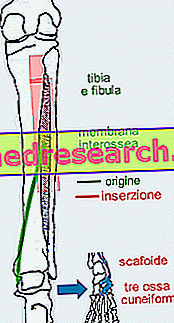
It continues with a tendon which runs behind the medial malleolus and which is divided into two bundles: the medial bundle, more robust, is fixed to the tuberosity of the navicular bone (or scaphoid), the weaker bundle is inserted at the three cuneiform bones.
It works by flexing the plantar (extending) the foot and participating in the movements of adduction (supination) and internal rotation of the foot. With your foot fixed to the ground, bring your leg close to your heel.
It is innervated by the tibial nerve (L4-L5)
| ORIGIN It originates from the inferior lip of the oblique line and from the posterior aspect of the tibia, from the superior part of the interosseous membrane, from the medial face of the fibula and from the surrounding intermuscular septa |
| INSERTION Tubercle of the scaphoid, 3 cuneiforms, 2nd-4th metatarsal |
| ACTION Extends (plantar flexes), adduces (supine) and participates in the movements of internal rotation of the foot. |
| INNERVATION Tibial (L4, L5) |
| Upper limb | Lower limb | Trunk | Abdomen | Articles |



